Introduction
“The value of a business is a function of how well the financial capital and the intellectual capital are managed by the human capital. You’d better get the human capital part right” (Bookbinder 161).
In the minds of many individuals and even some business owners, the term Human Resources (HR) is associated with the hiring and firing process. The purpose of the HR department, in their minds, does not go beyond formulating the requirements for particular positions, and then finding individuals in the labor market to fill these positions. This point of view is simplistic and easy to understand. At the same time, it is also incredibly wrong.
The roles and responsibilities of the HR managers have expanded far beyond the purposes recruitment and discharge. Nowadays, HR managers are responsible for many venues in a business environment, such as the formulation and facilitation of the company’s vision and mission, the establishment and cultivation of a healthy corporate culture, inspiration, training, and motivation of employees to aspire to new heights, as well being the agents of change.
The modern business landscape is evolving rapidly due to the advances in theoretical and practical knowledge. Competition becomes steeper, requiring a higher quality of organizational prowess from the company’s human resources. A modern HR manager needs to understand key developments in the business and external contexts within which HR operates. The purpose of this paper is to identify and review the external contextual factors affecting organizations, assess the impact of these factors on the HR function, and examine the HR’s role in strategy formulation and implementation.
Three Major Forces that Shape the HR Agenda
Models of HR Function
There are many models of HR function available for use. However, the three most popular models that can be found in the US are the following:
The Standard Causal Model of HRM. This model was popularized throughout the 1990s – early 2000s. This system is defined by its adherence to the company’s overall strategy. The HR department in this model is subservient and is meant to accomplish the company’s overall goals rather than inform them. The main purposes of the HR, according to this model, are hiring, training, appraisal, and compensation (Bailey, 34). These activities are supposed to lead to the increase in the overall company performance. Figure 1 illustrates the model:

The 8-Box Model. This type of model is popular in HR because of its accurate representation of internal and external factors that affect the HR performance in a particular company. The core of the system is represented by the causal chain of intended, actual, and perceived HR practices, which in turn lead to positive or negative HR outcomes. The internal factors that affect the core chain are the company’s configuration (history, culture, technology, and workforce), internal HR goals, and ultimate business goals (Bailey 50).
The external factors include external general market context (microeconomic and labor market), external market population context (competition, market, technology, and products), external legislative context, and external institutional population context. As it is possible to see in Figure 2, the HR core chain is not subservient to the overall company business strategy, seeking to inform it instead.
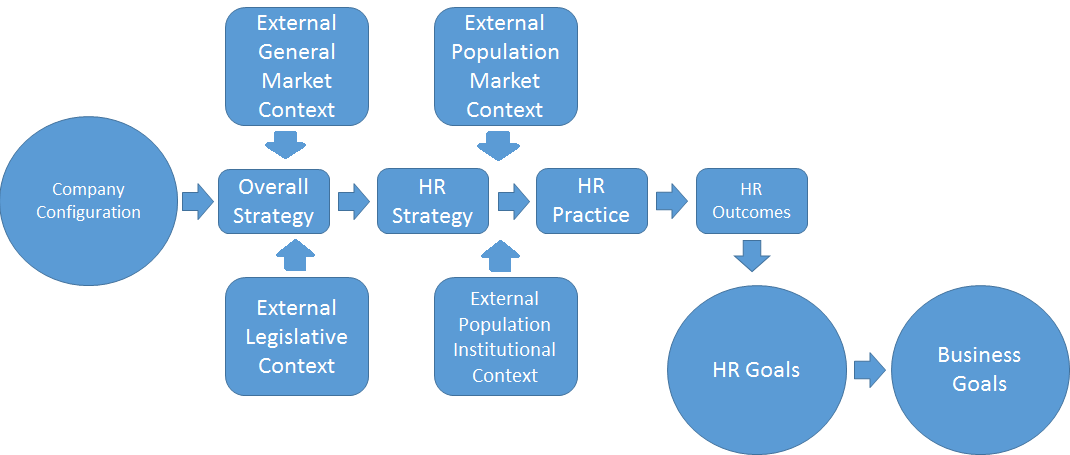
The HR Value Chain. The value chain model is considered to be one of the most efficient modern outlooks on the functions and responsibilities of the HR manager. The model is based around three major parameters, which help inform the HR practice, the strategies utilized to improve the quality of labor, and the metrics utilized to estimate the impact of the provided interventions. These parameters are efficiency, effectiveness, and impact (Bailey 68).
Efficiency-related activities and processes include workforce planning, training, compensation, organizational design, and downsizing. Effectiveness is determined by the outcomes of HRM, such as employee engagement, retention, presence, and culture. Lastly, the impact is determined by how well the organizational objectives were accomplished. Some of these objectives include profit, market value, market share, productivity, quality, and customer satisfaction (Bailey 69).
The main idea behind the model states that if the efficiency and effectiveness-related interventions are conducted properly, the end result should improve the value of the company. In addition, there is a reverse effect to the value chain concept. When the company performance is higher, the responsibilities of the HR department are also greatly increased, because companies have the resources to invest in HR programs. Figure 3 illustrates the three main components of the HRM value chain:
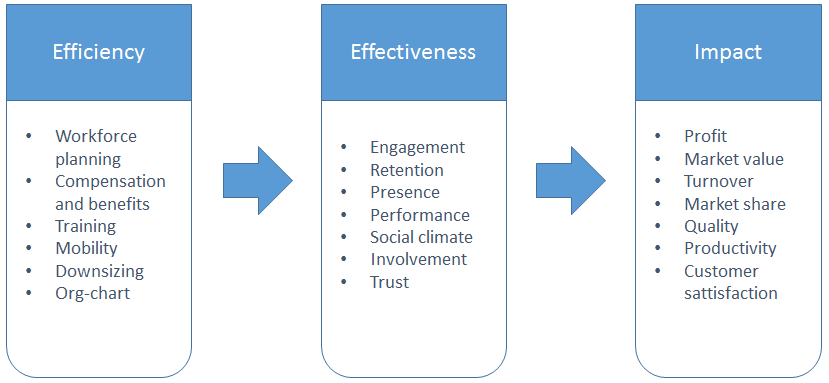
As it is possible to see, these HRM chains, while retaining many of the basic traits and objectives between one another, have different approach to the interpretation of the purposes of HRM, the connections and correlations between various branches, and the overall position of the department in the hierarchy.
HR Strategies
There are three general directions in HR strategy, all aimed at the overall improvement in the company. These strategies include high-performance management, high-commitment management, and high-involvement management. High-performance strategy seeks to enhance the results of labor and service activities by improving the quality of the work, the efficiency of the processes, the employee skills, and providing a medium in which individual talents could flourish. These practices are also known as High-Performance-Work-Systems (HPWS), and are utilized by companies that have high standards of quality for their products (Bratton and Gold 139).
High-commitment management, on the other hand, focuses on increasing the worker’s willingness to commit oneself to a company, its visions and goals, and facilitate a high quality of service on his or her own accord, without a direct exterior demand or involvement (Bratton and Gold 140). The focus of this strategy is on self-regulation, which can be achieved if labor provides a modicum of internal satisfaction. It is best used in services, where customer satisfaction is visible and tangible. Honest gratitude can produce increased levels of satisfaction in employees, motivating them to improve further.
High-involvement strategy is based on a theory of worker involvement. It states that an employee is more likely to produce great results if they are given an opportunity to make decisions in regards to their work. In some ways, it is similar to the high commitment management theory described above. However, the focus lies not on the external validation from customers or internal satisfaction, but on the feeling of power and control, which enables the employees to produce the product or service in the best possible manner (Bratton and Gold 146). This type of strategy is utilized in services where high initiative is required and where there are no rigid rules and frameworks to follow.
Stakeholder Expectations
Different kinds of stakeholders have different perceptions and expectations of the company and the business processes involved in its operations. This large conglomeration of people can be divided into two subgroups: internal and external stakeholders. Internal stakeholders are the managers, the employees, and the company shareholders. External stakeholders are the customers, the creditors, the government, and the community. The expectations for the company are typically as follows (Marchington 77):
- Managers: Expect a degree of freedom in decision-making, competence among the employees, and fair compensation for their efforts.
- Employees: Similar to managers in terms of compensation and competence from their supervisors. In addition, the majority of employees value the capacity to set objects in a clear and concise manner.
- Shareholders: Are largely interested in return of investments and the overall success of the company.
- Customers: Expect quality services at affordable prices as well as respect and loyalty from the company in the long-term perspective.
- Government: Expects the company to pay its dues on time, succeed in the market, and follow the established rules and regulations.
- Creditors: Expect return of investment.
As it is possible to see, there is a multitude of expectations coming from different stakeholder groups. Managing them and ensuring that these expectations are satisfied will lead to positive business outcomes.
PESTLE and SWOT Comparative Analysis
SWOT and PESTLE are tools used by managers in order to analyze the company from different angles. These two systems are relatively well-known even to people outside of management due to the relative simplicity and intuitive understanding of the criteria used to complete the analysis. SWOT and PESTLE are typically used in conjunction, because they analyze different areas. Therefore, a comparison between them would end in contrasting results.
SWOT stands for Strengths, Weaknesses, Opportunities, and Threats (Nankervis 37). This framework can be applied not only to a business as a whole, but even to a particular department within the company. It also can be applied to evaluate teams on an individual level. It provides a balanced view of internal and external factors that would affect a particular enterprise. Strengths and weaknesses sections are usually focused on the internal components, while opportunities and threats – on the external. A schematic of SWOT analysis is illustrated in Figure 4:

PESTLE stands for Political, Economic, Social, Technological, Legal, and Environmental factors (Nankervis 40). This analysis is an in-depth tool that allows analyzing the external environment. As it is possible to see, there are no dedicated fields for internal components of the company, though it is possible to analyze the internal factors by comparing them with external standards set up by the industry. Figure 5 illustrates the main components of PESTLE:

When comparing PESTLE with SWOT, it is possible to see that SWOT is largely oriented on the internal situation of the company, as even the Opportunities and Threats sections cannot be take out of context. PESTLE is an efficient tool for analyzing the industry and determining the company’s position in it. It can be attached to the realities of the company or detached from it, representing a separate analysis.
This is the reason why SWOT and PESTLE are often utilized together, as they provide a coherent picture of the company and the business environment. The strengths of PESTLE when compared to SWOT include greater focus on the external market, buyers, suppliers, and competitors. SWOT does not offer the same scope and breadth of the external picture. At the same time, if we compare SWOT to PESTLE, SWOT is more oriented on the internal processes within the company, something that PESTLE does not focus on.
Internal and External Factors that Impact the Organization
HRM and organizational performance are intertwined, as the purpose of HR is to accomplish company goals while simultaneously informing their policy towards customers, employees, and the community. As such, there is a number of internal and external factors that affect the performance of the HR department. These factors are as follows (Bailey 111):
- External labor pool (External). One of the main objectives of the HR department is to hire and retain talented individuals to work in the company. This factor is directly tied to the performance of the company, the compensation provided to the employees, and the willingness to go an extra mile. In a labor market with plenty of potential candidates, the HR department should focus on finding and hiring the best, whereas in the conditions of a limited employee pool the focus switches to training and retaining talent.
- Government regulations (External). The government plays a major role in setting up the fair playing field for the companies to compete in. In addition, the government informs HR practices by setting up the norms and conditions for labor and hiring, sometimes even imposing quotas based on race, gender, or capabilities (Bailey 115). An example of such a regulation would be the Americans with Disabilities Act.
- Growth levels (Internal). Different companies have different levels of estimated and actual growth. Young and enterprising companies are often looking to expand and claim a bigger market share, thus pursuing a more aggressive HR strategy focused on hiring, sifting through, and replacing individuals as needed (Bailey 119). Retention rates in these companies are typically larger. Other businesses, namely among the well-established and famous brands, focus more on retaining and helping individuals grow as professionals.
- Technological use (Internal). With digital software entering the HR department, many of its functions have become effectively improved. Namely, customer relations software enabled the simplification and analysis of customer feedback, sending newsletters, and providing information about the latest activities. In addition, organizational charts and Gantt charts are now in widespread use, enabling fluid scheduling and prompt replacements when needed (Bailey 119).
As it is possible to see, the factors provided above impact organizational performance, while at the same time remaining within the capacity of the HR department to influence and manage.
Strategy Formulation and Implementation
If a strategy is formulated using the standard causal model of HRM, the steps involved in the process are as follows (Bookbinder 140):
- Setting organizational objectives. Strategy is a tool for achieving organizational objectives. Deciding on what the organization seeks to accomplish in the short-term, long-term, and transitional perspectives is important for deciding the further course of action. As HRM is one of the instruments to use in achieving strategic objectives, its role at this stage is to inform the overall goals in accordance to the availability of human resources.
- Evaluating the organizational environment. This step involves measuring the strengths and weaknesses of the enterprise and comparing it with the external environment. SWOT and PESTLE are the tools to use at this stage. The purpose of the HRM is to help evaluate two stakeholder groups, namely the employees and the customers.
- Setting quantitative targets. Each department is supposed to have an array of quantitative parameters, which could be used to evaluate its effectiveness. With the HR department, it is difficult because the correlation between HRM success and organizational success is often qualitative rather than quantitative. An example of a quantifiable position in HRM is the overall turnover rate.
- Fulfilling divisional plans. Each division and subdivision in a company needs to have a series of overall macroeconomic objectives to help advance the enterprise in the market. During this stage, the purpose of the HR department could involve recruiting specific individuals to aid in the upcoming projects.
- Performance analysis. Before a new strategy is launched, an understanding of the company’s current capabilities based on past data must be obtained. The HR department plays an important role at this stage, as it can provide the productivity metrics for each individual employee and subdivision through the use of KPIs and other tools.
- Choice of strategy. This is the final step in the strategic formulation process of an organization. Based on the overall strategy, the HR department will adopt one of its own to further the company’s overall goals.
- Ethics and Accountability. The HR department is responsible for the introduction and sustenance of ethical standards in the organization. Ethics play a large role in every part of the organizational process, ranging from paying salaries on time to treating customers with dignity and respect. Ethical values should be directly stated in the company’s vision and mission purpose and encompass all stakeholders, including the customers, the shareholders, the stakeholders, and the surrounding communities.
This rigorous analysis proves that the HR department has influence on nearly every step of the planning and decision-making process.
Evaluation of Business Performance
One of the most popular ways of evaluating business performance is the use of a balanced scorecard. Before the concept was developed, most companies utilized short-term financial reports as a means of evaluating the success or failure of an enterprise at the end of the quartile. However, such a traditional approach was not a complete one, as it lacked the unquantifiable dimensions of business performance evaluation. As the company is built around its vision and mission, the evaluation of business performance has four indicators, which are as follows (Nankervis 91):
- Financial performance. This part of the scorecard responds for short-term profits and revenues. HR performance has an indirect impact on this key parameter, as its activities should lead to better engagement and performance. For example, employee retention in a hand-made chocolate boutique would mean that the quality and quantity of the produce would rise, leading to increased sales.
- Customer/Stakeholder satisfaction. This parameter is under the direct responsibility of the HR department. Ensuring customer and stakeholder satisfaction can be done through various internal and external means, including preferential studies and alterations in leadership and employee motivation.
- Internal business process efficiency. Although this indicator is under the responsibility of operational managers, the HR also influences this parameter by directly working with the people, encouraging them to show better efficiency and performance.
- Organizational capacity. The HR department is responsible for organizing and supplying the company with cadres.
As it is possible to see, the balanced scorecard retains the traditional measurements used in business analysis. At the same time, financial performance can only be useful in analyzing the past performance. It does not offer enough data to make accurate predictions. The other three steps provide data that could be used to project future efficiency.
Managing Change and Contextual Data in Business Analysis
Change is a necessary evil for any organization. Businesses that do not evolve and improve over time begin to stagnate and eventually lose their market share. HR plays an important role in managing change. Their duties involve implementing the processes of change, preparing the employees to adapt and accept it and promoting a healthy corporate culture enhances a company’s organizational capacity. Depending on the HR model utilized by the company, HR departments may be the initiators of change or simply help promote the corporate strategy decided by the board of directors, thus serving as facilitators of change.
Contextual data in business is separated into two large subgroups – qualitative and quantitative data. Quantitative data represents accurate information regarding various aspects of company life. Productivity is measured by a multitude of methods, one of which is KPI, or Key Performance Indicators. In repetitive and routine tasks, the quality of work can be measured by the speed of performance, number of completed activities per day, customer ratings, and others. Qualitative information, on the other hand, is often represented by unstructured data coming from customer feedback, interviews, questionnaires, surveys, and personal accounts. HR are required to interpret this data and formulate conclusions based on it (Bookbinder 89).
Industry information is a set of parameters that could be used as points of comparison for companies to grade themselves against. The industry standard represents the results found in the majority of the companies of similar size and scope. They can be used to determine if the company is doing fine or if alterations and improvements are needed (Bratton and Gold 20). A company graded below industry average is at risk of losing customers, while a business with above-average results can expect to claim additional market share.
The reason why contextual data is important in business analysis is because it provides information unique to the enterprise that can be used in future predictions. This data is required to estimate the effectiveness of existent policies, change operations, and the overall employee effectiveness. Lastly, trends in HR are a subject of constant attention due to the evolving nature of modern capitalism. The human capital is one of the greatest strengths a company could have. New leadership concepts, such as servant leadership and transformational leadership, can be used to improve the retention and satisfaction of employees. Six Sigma practices can drastically improve the quality of products and services (Bookbinder 17).
Conclusions
HRM is the key part of any company or enterprise. The management of human capital goes beyond the basic processes of hiring, firing, and administering rewards. It is a complex process that requires solid theoretical knowledge, practical experience, and leadership. Although in some companies HRM is used as a tool to further corporate goals, the department could also inform and shape the company’s practices according to the capabilities of the available personnel and the availability of new talent in the labor market. With the competition for highly-skilled employees among the top corporations increasing, the future will belong to the companies with the superior HRM.
Works Cited
Bailey, Catherine, et al. Strategic Human Resource Management. 2nd ed., Oxford University Press, 2018.
Bookbinder, Dave. The New ROI: Return on Individuals. Limelight Publishing, 2017.
Bratton, John, and Jeff Gold. Human Resource Management: Theory and Practice. 6th ed., Palgrave, 2017.
Marchington, Mick, et al. Human Resource Management at Work. 6th ed., CIPD, 2016.
Nankervis, Alan, et al. Human Resource Management: Strategy and Practice. 9th ed., AHRI, 2017.
Reiche, Sebastian B, et al., editors. Readings and Cases in International Human Resource Management. 6th ed., Routledge, 2017.
Appendix A

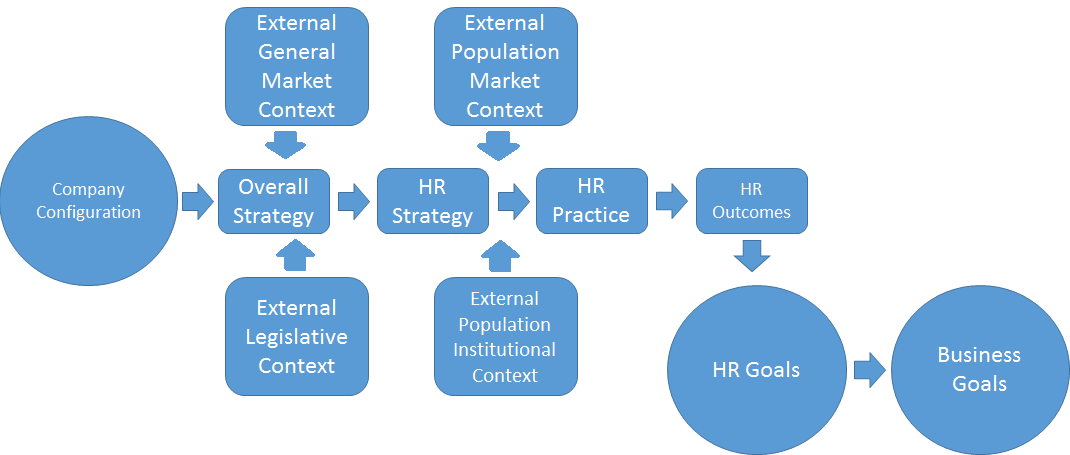
Appendix B
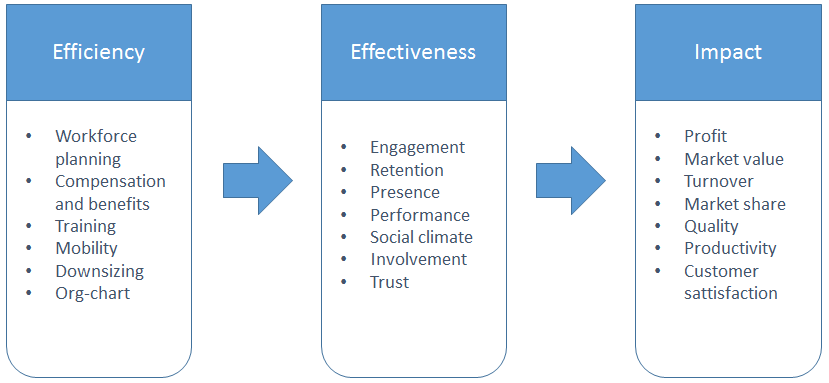
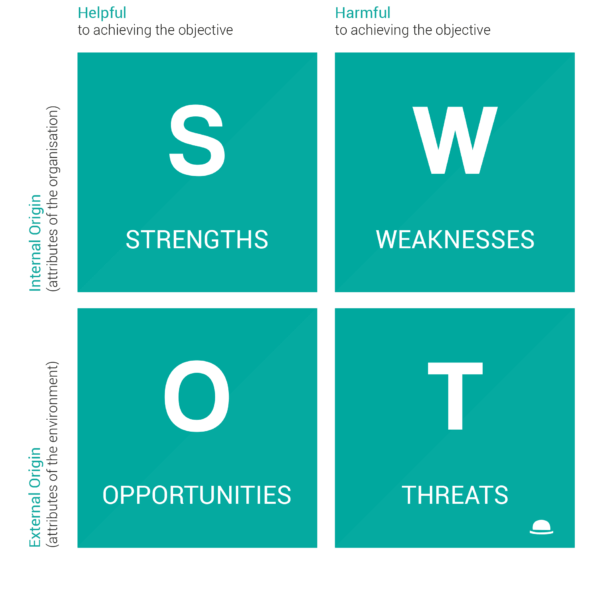
Appendix C

